Cardiovascular Toxicities Secondary to Biotherapy and Molecular Targeted Therapies in Neuroendocrine Neoplasms: A Systematic Review and Meta-Analysis of Randomized Placebo-Controlled Trials
Abstract
Simple Summary
Abstract
1. Introduction
2. Results
2.1. Study Selection
2.2. Representation in International Guidelines
2.3. Risk of Bias Assessment
2.4. Serious Toxicities’ Profile
2.5. All Grade Toxicities’ Profile
2.6. Serious Cardiac Toxicities’ Profile
2.7. Serious Vascular Toxicities’ Profile
2.8. Hypertension Secondary to Molecular Targeted Therapies
3. Discussion
4. Materials and Methods
4.1. Search Strategy and Study Selection
4.2. Outcomes and Data Extraction
4.3. Risk of Bias and Quality of Evidence Assessment
4.4. Statistical Analysis
5. Conclusions
Supplementary Materials
Author Contributions
Funding
Institutional Review Board Statement
Informed Consent Statement
Data Availability Statement
Acknowledgments
Conflicts of Interest
References
- Dasari, A.; Shen, C.; Halperin, D.; Zhao, B.; Zhou, S.; Xu, Y.; Shih, T.; Yao, J.C. Trends in the Incidence, Prevalence, and Survival Outcomes in Patients with Neuroendocrine Tumors in the United States. JAMA Oncol. 2017, 3, 1335–1342. [Google Scholar] [CrossRef] [PubMed]
- Roman, S.; Lin, R.; Sosa, J.A. Prognosis of medullary thyroid carcinoma: Demographic, clinical, and pathologic predictors of survival in 1252 cases. Cancer 2006, 107, 2134–2142. [Google Scholar] [CrossRef] [PubMed]
- Alexandraki, K.I.; Kaltsas, G. Gastroenteropancreatic neuroendocrine tumors: New insights in the diagnosis and therapy. Endocrine 2012, 41, 40–52. [Google Scholar] [CrossRef] [PubMed]
- Pavel, M.; Valle, J.W.; Eriksson, B.; Rinke, A.; Caplin, M.; Chen, J.; Costa, F.; Falkerby, J.; Fazio, N.; Gorbounova, V.; et al. ENETS Consensus Guidelines for the Standards of Care in Neuroendocrine Neoplasms: Systemic Therapy—Biotherapy and Novel Targeted Agents. Neuroendocrinology 2017, 105, 266–280. [Google Scholar] [CrossRef]
- Kaderli, R.M.; Spanjol, M.; Kollar, A.; Butikofer, L.; Gloy, V.; Dumont, R.A.; Seiler, C.A.; Christ, E.R.; Radojewski, P.; Briel, M.; et al. Therapeutic Options for Neuroendocrine Tumors: A Systematic Review and Network Meta-analysis. JAMA Oncol. 2019, 5, 480–489. [Google Scholar] [CrossRef] [PubMed]
- Oleinikov, K.; Korach, A.; Planer, D.; Gilon, D.; Grozinsky-Glasberg, S. Update in carcinoid heart disease—The heart of the matter. Rev. Endocr. Metab. Disord. 2021. [Google Scholar] [CrossRef] [PubMed]
- Liu, M.; Armeni, E.; Navalkissoor, S.; Davar, J.; Sullivan, L.; Leigh, C.; O’Mahony, L.F.; Hayes, A.; Mandair, D.; Chen, J.; et al. Cardiac Metastases in Patients with Neuroendocrine Tumours: Clinical Features, Therapy Outcomes, and Prognostic Implications. Neuroendocrinology 2020. [Google Scholar] [CrossRef] [PubMed]
- Alexandraki, K.I.; Daskalakis, K.; Tsoli, M.; Grossman, A.B.; Kaltsas, G.A. Endocrinological Toxicity Secondary to Treatment of Gastroenteropancreatic Neuroendocrine Neoplasms (GEP-NENs). Trends Endocrinol. Metab. 2020, 31, 239–255. [Google Scholar] [CrossRef]
- Heidarpour, M.; Shafie, D.; Aminorroaya, A.; Sarrafzadegan, N.; Farajzadegan, Z.; Nouri, R.; Najimi, A.; Dimopolou, C.; Stalla, G. Effects of somatostatin analog treatment on cardiovascular parameters in patients with acromegaly: A systematic review. J. Res. Med. Sci. 2019, 24, 29. [Google Scholar] [CrossRef]
- Denney, W.D.; Kemp, W.E., Jr.; Anthony, L.B.; Oates, J.A.; Byrd, B.F., 3rd. Echocardiographic and biochemical evaluation of the development and progression of carcinoid heart disease. J. Am. Coll. Cardiol. 1998, 32, 1017–1022. [Google Scholar] [CrossRef]
- Cheng, H.; Force, T. Molecular mechanisms of cardiovascular toxicity of targeted cancer therapeutics. Circ. Res. 2010, 106, 21–34. [Google Scholar] [CrossRef] [PubMed]
- Liu, K.L.; Chen, J.S.; Chen, S.C.; Chu, P.H. Cardiovascular Toxicity of Molecular Targeted Therapy in Cancer Patients: A Double-Edged Sword. Acta Cardiol. Sin. 2013, 29, 295–303. [Google Scholar]
- Hasinoff, B.B. The cardiotoxicity and myocyte damage caused by small molecule anticancer tyrosine kinase inhibitors is correlated with lack of target specificity. Toxicol. Appl. Pharmacol. 2010, 244, 190–195. [Google Scholar] [CrossRef]
- Common Terminology Criteria for Adverse Events v5.0 (CTCAE). Available online: https://ctep.cancer.gov/protocoldevelopment/electronic_applications/ctc.htm (accessed on 1 January 2021).
- Wells, S.A., Jr.; Asa, S.L.; Dralle, H.; Elisei, R.; Evans, D.B.; Gagel, R.F.; Lee, N.; Machens, A.; Moley, J.F.; Pacini, F.; et al. Revised American Thyroid Association guidelines for the management of medullary thyroid carcinoma. Thyroid 2015, 25, 567–610. [Google Scholar] [CrossRef] [PubMed]
- Schlumberger, M.; Bastholt, L.; Dralle, H.; Jarzab, B.; Pacini, F.; Smit, J.W.; European Thyroid Association Task, F. 2012 European thyroid association guidelines for metastatic medullary thyroid cancer. Eur. Thyroid. J. 2012, 1, 5–14. [Google Scholar] [CrossRef] [PubMed]
- Caplin, M.E.; Pavel, M.; Cwikla, J.B.; Phan, A.T.; Raderer, M.; Sedlackova, E.; Cadiot, G.; Wolin, E.M.; Capdevila, J.; Wall, L.; et al. Lanreotide in metastatic enteropancreatic neuroendocrine tumors. N. Eng. J. Med. 2014, 371, 224–233. [Google Scholar] [CrossRef] [PubMed]
- Rinke, A.; Muller, H.-H.; Schade-Brittinger, C.; Klose, K.-J.; Barth, P.; Wied, M.; Mayer, C.; Aminossadati, B.; Pape, U.-F.; Blaker, M.; et al. Placebo-controlled, double-blind, prospective, randomized study on the effect of octreotide LAR in the control of tumor growth in patients with metastatic neuroendocrine midgut tumors: A report from the PROMID Study Group. J. Clin. Oncol. Off. J. Am. Soc. Clin. Oncol. 2009, 27, 4656–4663. [Google Scholar] [CrossRef]
- Vinik, A.I.; Wolin, E.M.; Liyanage, N.; Gomez-Panzani, E.; Fisher, G.A. Evaluation of lanreotide depot/autogel efficacy and safety as a carcinoid syndrome treatment (elect): A randomized, double-blind, placebo-controlled trial. Endocr. Prac. Off. J. Am. Coll. Endocrinol. Am. Assoc. Clin. Endocrinol. 2016, 22, 1068–1080. [Google Scholar] [CrossRef]
- Kulke, M.H.; Horsch, D.; Caplin, M.E.; Anthony, L.B.; Bergsland, E.; Oberg, K.; Welin, S.; Warner, R.R.P.; Lombard-Bohas, C.; Kunz, P.L.; et al. Telotristat Ethyl, a Tryptophan Hydroxylase Inhibitor for the Treatment of Carcinoid Syndrome. J. Clin. Oncol. Off. J. Am. Soc. Clin. Oncol. 2017, 35, 14–23. [Google Scholar] [CrossRef]
- Pavel, M.; Gross, D.J.; Benavent, M.; Perros, P.; Srirajaskanthan, R.; Warner, R.R.P.; Kulke, M.H.; Anthony, L.B.; Kunz, P.L.; Horsch, D.; et al. Telotristat ethyl in carcinoid syndrome: Safety and efficacy in the TELECAST phase 3 trial. Endocr. Relat. Cancer 2018, 25, 309–322. [Google Scholar] [CrossRef] [PubMed]
- Kulke, M.H.; O’Dorisio, T.; Phan, A.; Bergsland, E.; Law, L.; Banks, P.; Freiman, J.; Frazier, K.; Jackson, J.; Yao, J.C.; et al. Telotristat etiprate, a novel serotonin synthesis inhibitor, in patients with carcinoid syndrome and diarrhea not adequately controlled by octreotide. Endocr. Relat. Cancer 2014, 21, 705–714. [Google Scholar] [CrossRef] [PubMed]
- Pavel, M.E.; Baudin, E.; Oberg, K.E.; Hainsworth, J.D.; Voi, M.; Rouyrre, N.; Peeters, M.; Gross, D.J.; Yao, J.C. Efficacy of everolimus plus octreotide LAR in patients with advanced neuroendocrine tumor and carcinoid syndrome: Final overall survival from the randomized, placebo-controlled phase 3 RADIANT-2 study. Ann. Oncol. Off. J. Eur. Soc. Med. Oncol. 2017, 28, 1569–1575. [Google Scholar] [CrossRef] [PubMed]
- Yao, J.C.; Shah, M.H.; Ito, T.; Bohas, C.L.; Wolin, E.M.; Van Cutsem, E.; Hobday, T.J.; Okusaka, T.; Capdevila, J.; de Vries, E.G.E.; et al. Everolimus for advanced pancreatic neuroendocrine tumors. N. Eng. J. Med. 2011, 364, 514–523. [Google Scholar] [CrossRef] [PubMed]
- Yao, J.C.; Fazio, N.; Singh, S.; Buzzoni, R.; Carnaghi, C.; Wolin, E.; Tomasek, J.; Raderer, M.; Lahner, H.; Voi, M.; et al. Everolimus for the treatment of advanced, non-functional neuroendocrine tumours of the lung or gastrointestinal tract (RADIANT-4): A randomised, placebo-controlled, phase 3 study. Lancet 2016, 387, 968–977. [Google Scholar] [CrossRef]
- Raymond, E.; Dahan, L.; Raoul, J.-L.; Bang, Y.-J.; Borbath, I.; Lombard-Bohas, C.; Valle, J.; Metrakos, P.; Smith, D.; Vinik, A.; et al. Sunitinib malate for the treatment of pancreatic neuroendocrine tumors. N. Eng. J. Med. 2011, 364, 501–513. [Google Scholar] [CrossRef] [PubMed]
- Wells, S.A., Jr.; Robinson, B.G.; Gagel, R.F.; Dralle, H.; Fagin, J.A.; Santoro, M.; Baudin, E.; Elisei, R.; Jarzab, B.; Vasselli, J.R.; et al. Vandetanib in patients with locally advanced or metastatic medullary thyroid cancer: A randomized, double-blind phase III trial. J. Clin. Oncol. Off. J. Am. Soc. Clin. Oncol. 2012, 30, 134–141. [Google Scholar] [CrossRef]
- Schlumberger, M.; Elisei, R.; Müller, S.; Schöffski, P.; Brose, M.; Shah, M.; Licitra, L.; Krajewska, J.; Kreissl, M.C.; Niederle, B.; et al. Overall survival analysis of EXAM, a phase III trial of cabozantinib in patients with radiographically progressive medullary thyroid carcinoma. Ann. Oncol. Off. J. Eur. Soc. Med. Oncol. 2017, 28, 2813–2819. [Google Scholar] [CrossRef]
- Xu, J.; Shen, L.; Bai, C.; Wang, W.; Li, J.; Yu, X.; Li, Z.; Li, E.; Yuan, X.; Chi, Y.; et al. Surufatinib in advanced pancreatic neuroendocrine tumours (SANET-p): A randomised, double-blind, placebo-controlled, phase 3 study. Lancet Oncol. 2020, 21, 1489–1499. [Google Scholar] [CrossRef]
- Rocio Garcia-Carbonero, M.B.; Fonseca, P.J.; Castellano, D.; Alonso, T.; Teule, A.; Custodio, A.; Tafuto, S.; Munoa, A.L.; Spada, F.; López-López, C.; et al. A phase II/III randomized double-blind study of octreotide acetate LAR with axitinib versus octreotide acetate LAR with placebo in patients with advanced G1-G2 NETs of non-pancreatic origin (AXINET trial-GETNE-1107). J. Clin. Oncol. 2021. [Google Scholar] [CrossRef]
- Bergsland, E.K.; Mahoney, M.R.; Asmis, T.R.; Hall, N.; Kumthekar, P.; Maitland, M.L.; Niedzwiecki, D.; Nixon, A.B.; O’Reilly, E.M.; Schwartz, L.H.; et al. Meyerhardt. Prospective randomized phase II trial of pazopanib versus placebo in patients with progressive carcinoid tumors (CARC) (Alliance A021202). Am. Soc. Clin. Oncol. 2019. [Google Scholar] [CrossRef]
- Xu, J.; Shen, L.; Zhou, Z.; Li, J.; Bai, C.; Chi, Y.; Li, Z.; Xu, N.; Li, E.; Liu, T.; et al. Surufatinib in advanced extrapancreatic neuroendocrine tumours (SANET-ep): A randomised, double-blind, placebo-controlled, phase 3 study. Lancet Oncol. 2020, 21, 1500–1512. [Google Scholar] [CrossRef]
- Dam, G.; Gronbaek, H.; Sorbye, H.; Thiis Evensen, E.; Paulsson, B.; Sundin, A.; Jensen, C.; Ebbesen, D.; Knigge, U.; Tiensuu Janson, E. Prospective Study of Chromogranin A as a Predictor of Progression in Patients with Pancreatic, Small-Intestinal, and Unknown Primary Neuroendocrine Tumors. Neuroendocrinology 2020, 110, 217–224. [Google Scholar] [CrossRef]
- Wedin, M.; Mehta, S.; Angeras-Kraftling, J.; Wallin, G.; Daskalakis, K. The Role of Serum 5-HIAA as a Predictor of Progression and an Alternative to 24-h Urine 5-HIAA in Well-Differentiated Neuroendocrine Neoplasms. Biology 2021, 10, 76. [Google Scholar] [CrossRef] [PubMed]
- Hall, P.S.; Harshman, L.C.; Srinivas, S.; Witteles, R.M. The frequency and severity of cardiovascular toxicity from targeted therapy in advanced renal cell carcinoma patients. JACC Heart Fail. 2013, 1, 72–78. [Google Scholar] [CrossRef] [PubMed]
- Schmidinger, M.; Zielinski, C.C.; Vogl, U.M.; Bojic, A.; Bojic, M.; Schukro, C.; Ruhsam, M.; Hejna, M.; Schmidinger, H. Cardiac toxicity of sunitinib and sorafenib in patients with metastatic renal cell carcinoma. J. Clin. Oncol. 2008, 26, 5204–5212. [Google Scholar] [CrossRef]
- Richards, C.J.; Je, Y.; Schutz, F.A.; Heng, D.Y.; Dallabrida, S.M.; Moslehi, J.J.; Choueiri, T.K. Incidence and risk of congestive heart failure in patients with renal and nonrenal cell carcinoma treated with sunitinib. J. Clin. Oncol. 2011, 29, 3450–3456. [Google Scholar] [CrossRef]
- Cumpston, M.; Li, T.; Page, M.J.; Chandler, J.; Welch, V.A.; Higgins, J.P.; Thomas, J. Updated guidance for trusted systematic reviews: A new edition of the Cochrane Handbook for Systematic Reviews of Interventions. Cochrane Database Syst. Rev. 2019, 10, ED000142. [Google Scholar] [CrossRef]
- Moher, D.; Liberati, A.; Tetzlaff, J.; Altman, D.G.; Group, P. Preferred reporting items for systematic reviews and meta-analyses: The PRISMA statement. BMJ 2009, 339, b2535. [Google Scholar] [CrossRef] [PubMed]
- Guyatt, G.H.; Oxman, A.D.; Vist, G.E.; Kunz, R.; Falck-Ytter, Y.; Alonso-Coello, P.; Schunemann, H.J.; Group, G.W. GRADE: An emerging consensus on rating quality of evidence and strength of recommendations. BMJ 2008, 336, 924–926. [Google Scholar] [CrossRef] [PubMed]
- Lawson, R. Small sample confidence intervals for the odds ratio. Commun. Stat. Simul. Comput. 2004, 33, 1095–1113. [Google Scholar] [CrossRef]
- DerSimonian, R.; Laird, N. Meta-analysis in clinical trials. Control. Clin. Trials 1986, 7, 177–188. [Google Scholar] [CrossRef]
- Higgins, J.P.; Thompson, S.G. Quantifying heterogeneity in a meta-analysis. Stat. Med. 2002, 21, 1539–1558. [Google Scholar] [CrossRef] [PubMed]
- Sterne, J.A.; Sutton, A.J.; Ioannidis, J.P.; Terrin, N.; Jones, D.R.; Lau, J.; Carpenter, J.; Rucker, G.; Harbord, R.M.; Schmid, C.H.; et al. Recommendations for examining and interpreting funnel plot asymmetry in meta-analyses of randomised controlled trials. BMJ 2011, 343, d4002. [Google Scholar] [CrossRef] [PubMed]
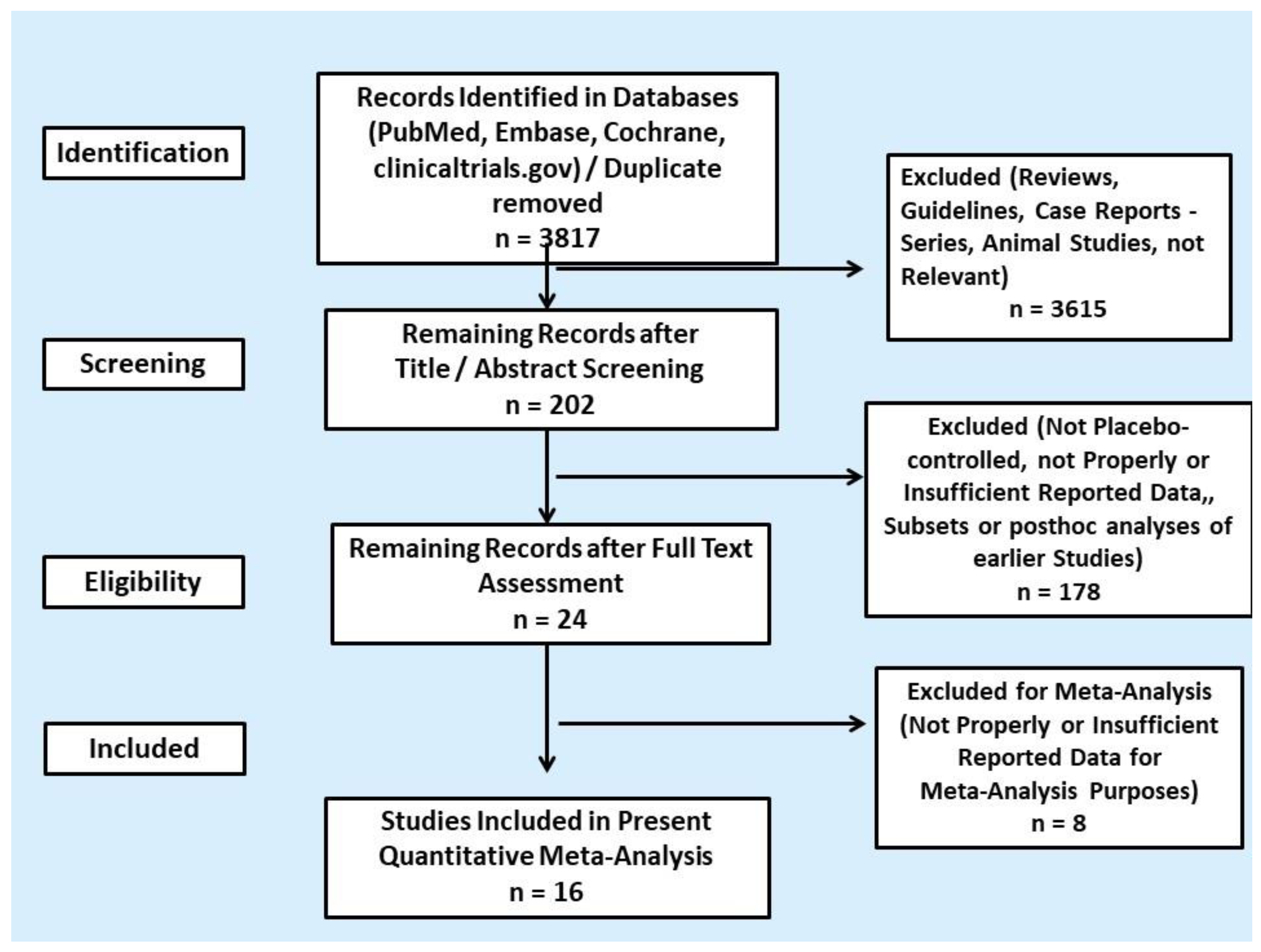

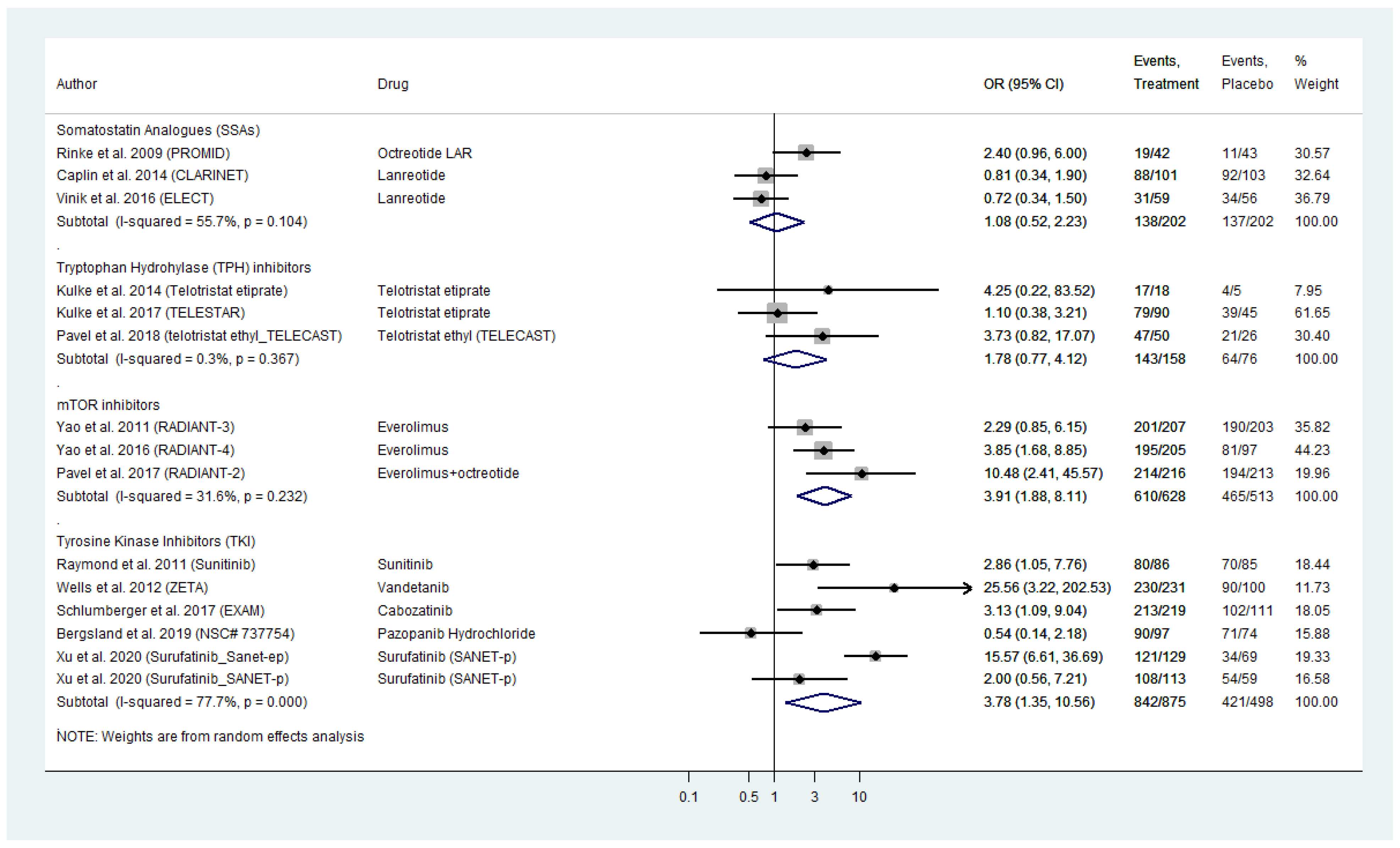
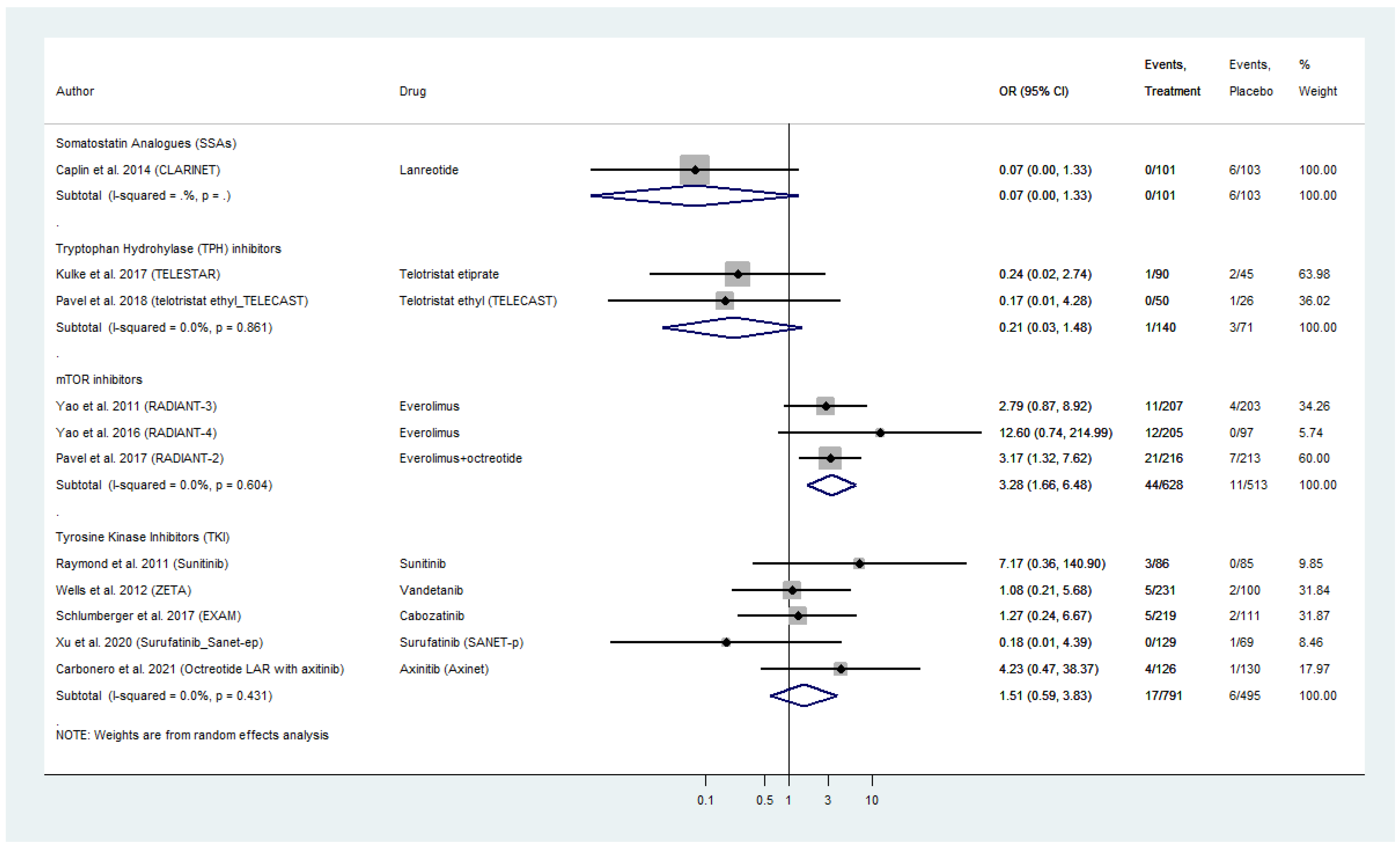
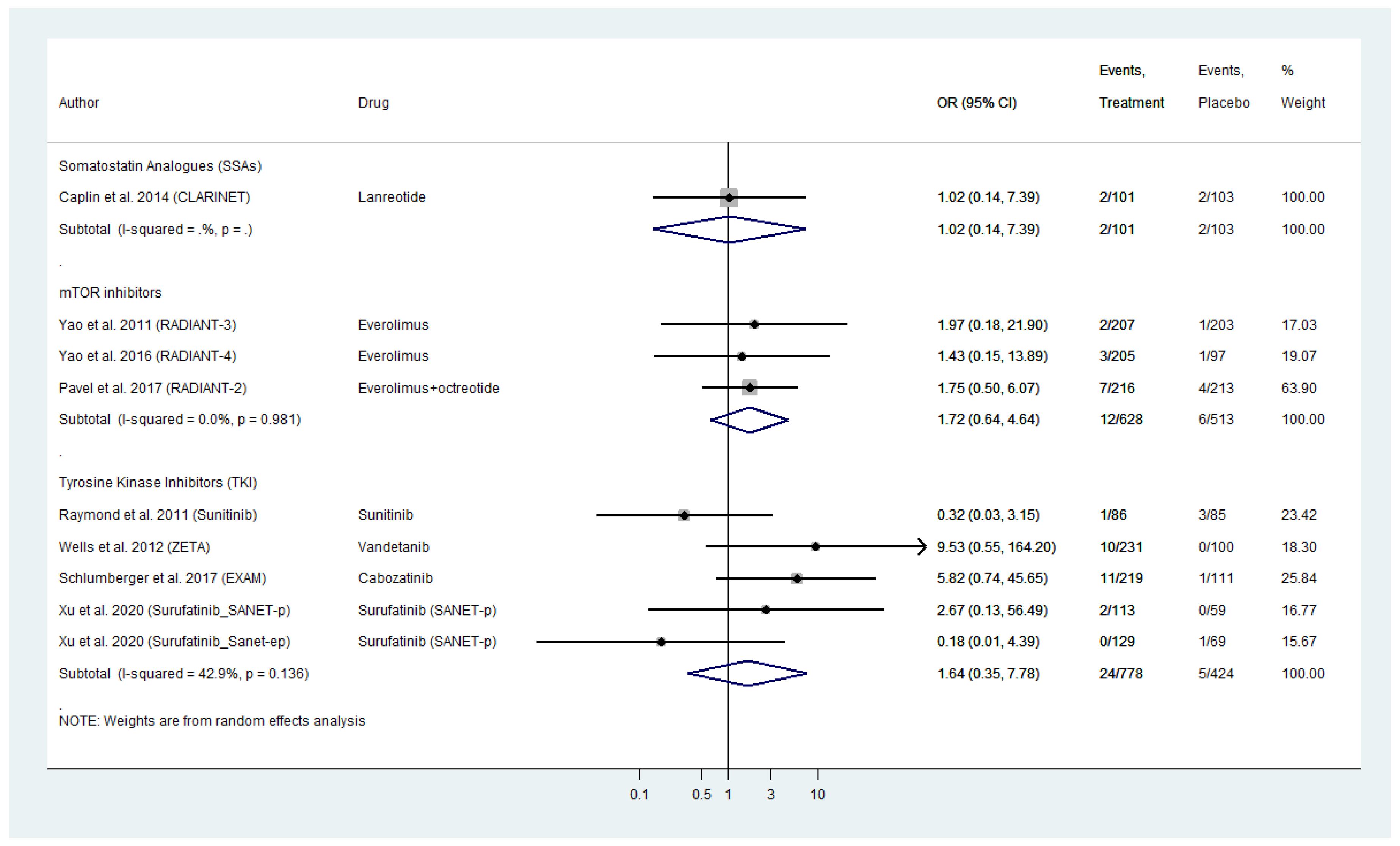
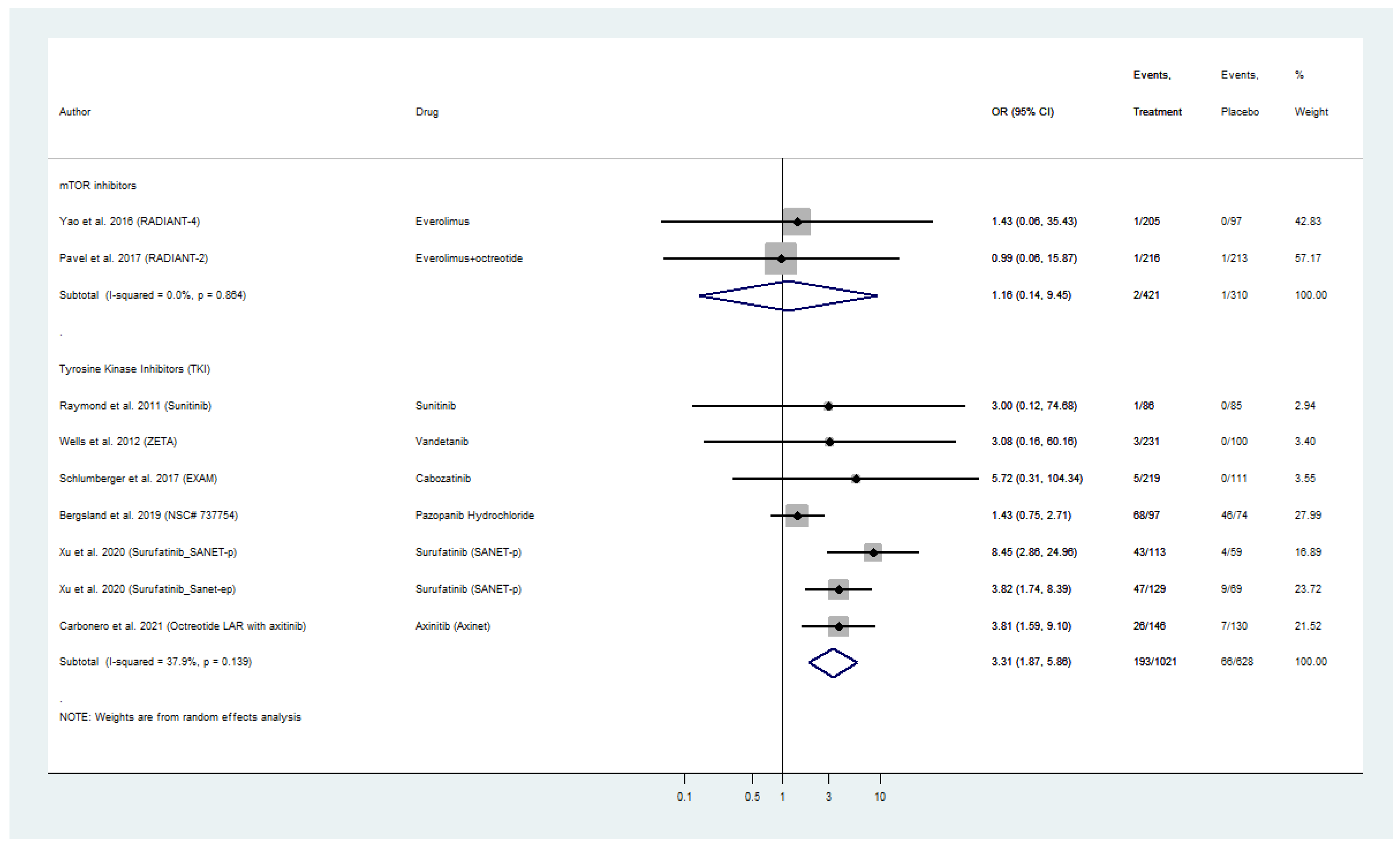
| Study | Drug | Origin | Type of Treatment | Median Treatment Duration | Median Follow-Up [Months] | Complete Follow-Up [%] | Sample Size Calculation | N Participants Randomized | Included in Enets, ATA/ETA Guidelines | Industry Sponsorship |
|---|---|---|---|---|---|---|---|---|---|---|
| SSAs | ||||||||||
| Caplin et al., 2014 [17] (CLARINET) | Lanreotide | 14 countries | Lanreotide 120 mg/28 d Placebo | 24.0 15.0 | n.a n.a. | 100 | Yes | 101 103 | Yes | Yes |
| Rinke et al., 2009 [18] (PROMID). | Octreotide LAR | Germany | Octreotide LAR 30 mg/28 d Placebo | n.d n.d. | n.a. n.a. | 99 | Yes | 42 43 | Yes | Yes |
| Vinik et al., 2016 [19] (ELECT). | Lanreotide | 11 countries | Lanreotide 120 mg/4weeks Placebo | 4.6 3.7 | n.a. n.a. | 99 | Yes | 86 85 | Yes | Yes |
| TPH Inhibitors | ||||||||||
| Kulke et al., 2017 [20] (TELESTAR). | Telotristat etiprate | 12 countries | Telotristat ethyl 250 mg or 500 mg three times per day or placebo three times per day | 12.0 12.0 | n.a. n.a. | 100 | Yes | 45 45 45 | No | Yes |
| Pavel et al., 2018 [21] (TELECAST). | Telotristat ethyl | 11 counties | Telotristat ethyl 250 mg tid or 500 mg tid or placebo | 12.0 12.0 | 36 | 89 | Yes | 26 25 25 | No | Yes |
| Kulke et al., 2014 [22] | Telotristat etiprate | USA | telotristat etiprate 150 mg or 250 mg or 350 mg or 500 mg tid or placebo | 4.0 4.0 4.0 4.0 4.0 | n.a. n.a. | 95 | Yes | 5 3 3 3 9 | No | Yes |
| mTOR Inhibitors | ||||||||||
| Pavel et al., 2017 [23] (RADIANT-2). | Everolimus + octreotide | 16 countries | Everolimus 10 mg/d + octreotide LAR 30 mg/28 d Placebo + octreotide LAR 30 mg/28 d | 9.3 9.2 | n.a. n.a. | 100 | Yes | 216 213 | Yes | Yes |
| Yao et al., 2011 [24] (RADIANT-3). | Everolimus | 18 countries | Everolimus 10 mg/d Placebo | 8.8 3.7 | 17 17 | 62 | Yes | 207 203 | Yes | Yes |
| Yao et al., 2016 [25] (RADIANT-4). | Everolimus | 25 countries | Everolimus 10 mg/d Placebo | 9.3 4.5 | 21 21 | Above 80 | Yes | 205 97 | Yes | Yes |
| TKI | ||||||||||
| Raymond et al., 2011 [26] | Sunitinib | 11 countries | Sunitinib 37.5 mg/d Placebo | 4.6 3.7 | n.a. n.a. | 99 | Yes | 86 85 | Yes | Yes |
| Wells et al., 2012 [27] (ZETA) | Vandetanib | 3 countries | Vandetanib 300 mg vs. placebo | n.a. n.a. | 24 | 100 | Yes | 330 | Yes | Yes |
| Schlumberger et al., 2017 [28] (EXAM). | Cabozatinib | Germany | Cabozantinib vs. placebo | n.a. n.a. | n.a. n.a. | 99.7 | Yes | 330 | No | Yes |
| Xu et al., 2020 [29] (SANET-p) | Surufatinib | China | Surufatinib 300 mg vs. placebo | 7.6 4.1 | 19.3 11.1 | n.a | Yes | 172 | No | Yes |
| Carbonero et al., 2021 [30] (AXINET) | Axinitib | NA | Axitinib 5 mg BID + Sandostatin LAR 30 mg/28 days | n.a. n.a. | n.a. n.a. | n.a. | Yes | 126 130 | No | Yes |
| Bergland et al. [31] 2019 | Pazopanib Hydrochloride | Pazopanib 800 mg PO QD on days 1–28 vs. placebo | 60 60 | 60 60 | 100 | Yes | 97 74 | No | Yes | |
| Xu et al., 2020 [32] (SANET-ep). | Surufatinib | China | Surufatinib 300 mg vs. placebo | 7.1 4.8 | 13.8 16.6 | 100 | Yes | 88 53 | No | Yes |
| Study | Random Sequence Generation | Allocation Concealment | Blinding of Participants and Personnel | Blinding of Outcome Assessment | Incomplete Outcome Data | Selective Reporting | Other Bias |
|---|---|---|---|---|---|---|---|
| Caplin et al., 2014 [17] (CLARINET). | (-) | (-) | (-) | (-) | (-) | (-) | ? |
| Rinke et al., 2009 [18] (PROMID) | (-) | (-) | (-) | (-) | (-) | (-) | ? |
| Vinik et al., 2016 [19] (ELECT). | (-) | (-) | (-) | ? | (-) | (-) | (-) |
| Kulke et al., 2017 [20] (TELESTAR). | ? | ? | ? | ? | (-) | (-) | (-) |
| Pavel et al., 2018 [21] (TELECAST). | (-) | (-) | (+) | (+) | (-) | (-) | (-) |
| Kulke et al., 2014 [22] | ? | ? | ? | ? | (-) | (-) | (-) |
| Pavel et al., 2017 [23] (RADIANT-2). | ? | (-) | (-) | (-) | (-) | (-) | ? |
| Yao et al., 2011 (RADIANT-3) [24]. | (-) | (-) | (-) | (-) | (-) | (-) | ? |
| Yao et al., 2016 (RADIANT-4) [25]. | (-) | (-) | ? | ? | (-) | (-) | ? |
| Raymond et al., 2011 [26] | ? | ? | (-) | (-) | ? | (-) | ? |
| Wells et al., 2012 [27] (ZETA). | ? | ? | (-) | (-) | (-) | (-) | ? |
| Schlumberger et al. [28] 2017 (EXAM). | ? | ? | (-) | (-) | (-) | (-) | ? |
| Xu et al., 2020 [29] (SANET-p). | (+) | (+) | (+) | (+) | (+) | (-) | ? |
| Carbonero et al., 2021 [30] (AXINET) | (+) | ? | (+) | (+) | ? | (-) | (-) |
| Bergsland et al. [31] 2019 | (+) | ? | (+) | ? | (-) | (-) | ? |
| Xu et al., 2020 [32] (SANET-ep). | (+) | (+) | (+) | (+) | (+) | (-) | (-) |
Publisher’s Note: MDPI stays neutral with regard to jurisdictional claims in published maps and institutional affiliations. |
© 2021 by the authors. Licensee MDPI, Basel, Switzerland. This article is an open access article distributed under the terms and conditions of the Creative Commons Attribution (CC BY) license (https://creativecommons.org/licenses/by/4.0/).
Share and Cite
Aktypis, C.; Spei, M.-E.; Yavropoulou, M.; Wallin, G.; Koumarianou, A.; Kaltsas, G.; Kassi, E.; Daskalakis, K. Cardiovascular Toxicities Secondary to Biotherapy and Molecular Targeted Therapies in Neuroendocrine Neoplasms: A Systematic Review and Meta-Analysis of Randomized Placebo-Controlled Trials. Cancers 2021, 13, 2159. https://doi.org/10.3390/cancers13092159
Aktypis C, Spei M-E, Yavropoulou M, Wallin G, Koumarianou A, Kaltsas G, Kassi E, Daskalakis K. Cardiovascular Toxicities Secondary to Biotherapy and Molecular Targeted Therapies in Neuroendocrine Neoplasms: A Systematic Review and Meta-Analysis of Randomized Placebo-Controlled Trials. Cancers. 2021; 13(9):2159. https://doi.org/10.3390/cancers13092159
Chicago/Turabian StyleAktypis, Charalampos, Maria-Eleni Spei, Maria Yavropoulou, Göran Wallin, Anna Koumarianou, Gregory Kaltsas, Eva Kassi, and Kosmas Daskalakis. 2021. "Cardiovascular Toxicities Secondary to Biotherapy and Molecular Targeted Therapies in Neuroendocrine Neoplasms: A Systematic Review and Meta-Analysis of Randomized Placebo-Controlled Trials" Cancers 13, no. 9: 2159. https://doi.org/10.3390/cancers13092159
APA StyleAktypis, C., Spei, M.-E., Yavropoulou, M., Wallin, G., Koumarianou, A., Kaltsas, G., Kassi, E., & Daskalakis, K. (2021). Cardiovascular Toxicities Secondary to Biotherapy and Molecular Targeted Therapies in Neuroendocrine Neoplasms: A Systematic Review and Meta-Analysis of Randomized Placebo-Controlled Trials. Cancers, 13(9), 2159. https://doi.org/10.3390/cancers13092159









